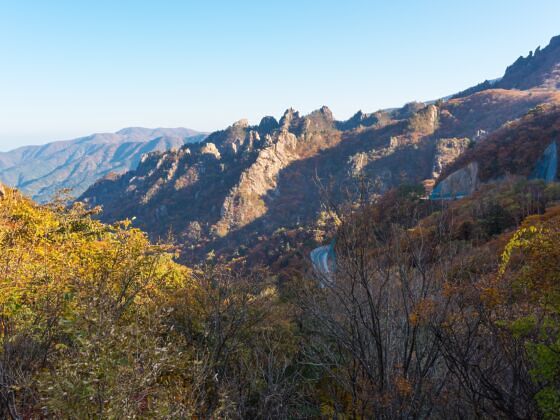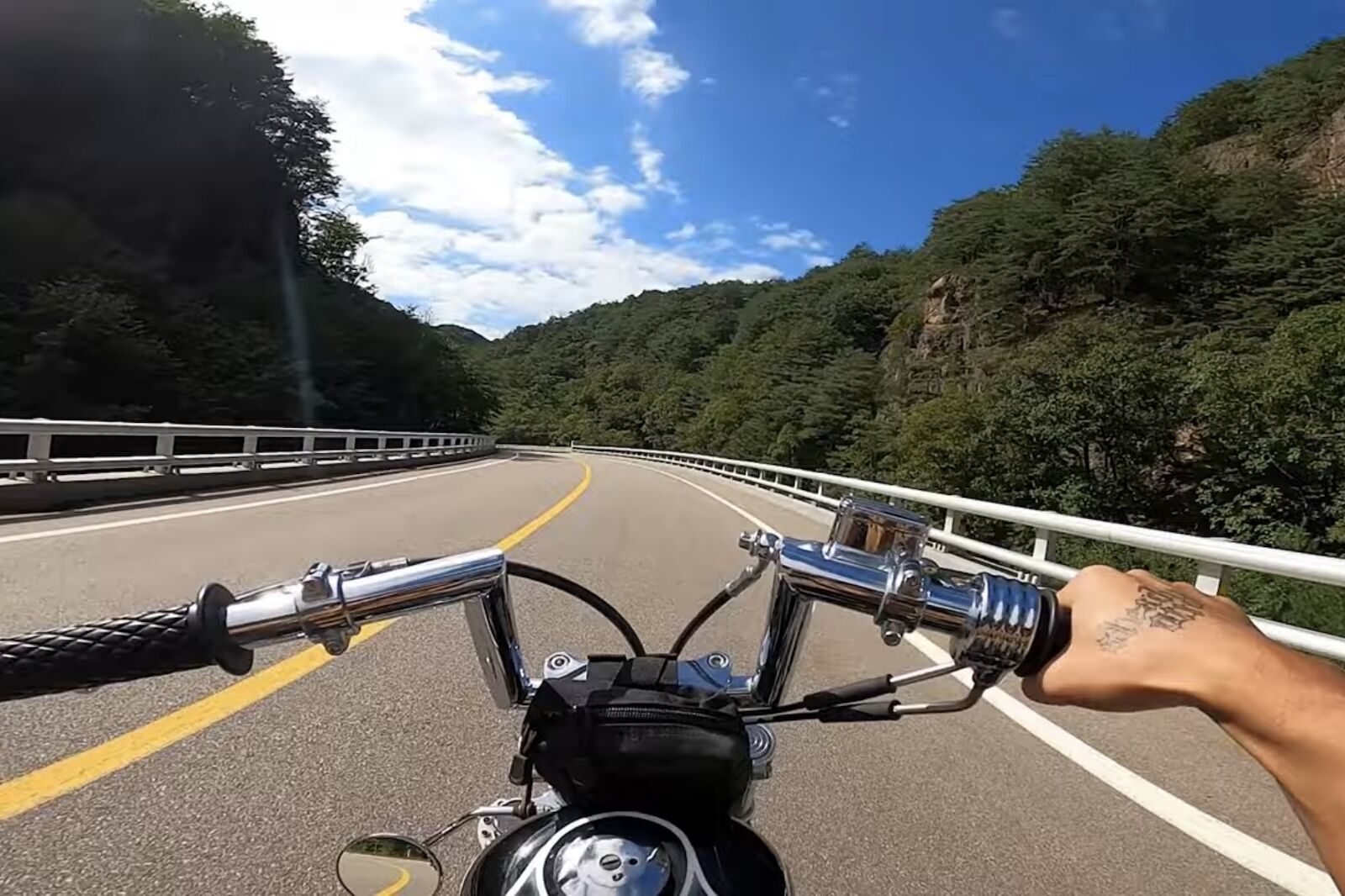I’d been riding my Royal Enfield Classic 350 motorcycle out in the Korean countryside for about six months, the entirety of my riding experience, when I decided it was time to go on my first long-distance motorcycle trip. My partner and I filled our bikes’ side bags with our sleeping bags and camping chairs, tied the tent and our backpacks to the passenger seats, and set off on our coast-to-coast adventure on Korea’s old town mountain roads.


Mountain Roads and Motorcycles: A Thrilling Ride Across Korea's Scenic Routes
Motorcycles are not allowed on expressways in Korea, so when it’s time to swap the West Coast city bustle of Seoul and Incheon for the sandy beaches and blue oceans of the East Coast (and vice versa), bikers will take one of two roads: Hangyeryeong (Route 44) or Misiryeong (Route 56). Along the way? 5,000 feet in elevation and curves through Korea’s outstanding Seoraksan National Park. The routes are also popular with drivers looking to take the scenic route to see the epic mountain views. I heard these routes were challenging — assumedly because of the increase in travel time compared to the expressways and it being “through the mountains” — but I had very little idea of how literally “through the mountains” they really are.

Photo: Minseok Kim
There’s no better feeling than getting on a motorcycle on a warm day when the sky is blue, the sun is shining, and the wind is just cool enough to feel refreshing on your skin and hair. Particularly when there’s no place you need to be and you can drive to your heart’s content. Riding feels connected to your surroundings and you notice everything: the wind, smells, sounds, the road texture, the small (and bigger) bumps, the machinery of the bike. Hearing the roar of the engine as your hands twist to accelerate is a liberating, addictive feeling.
It wasn’t long on my ride before the highway barriers and gray roads changed to tree trunks, blurred greenery, and imposing rocky mountain walls. Corners started to appear more frequently, each one tighter than the last. I tried to keep everything I’d learned about taking corners in mind: approach slowly, lean in, and slightly accelerate out — gripping the body of the bike with my thighs as if my life depended on it. At first, it was fun, almost like a video game. We were gaining elevation when what could’ve been a nightmare began: getting stuck behind a very slow car struggling with the corners and elevation. It was getting harder to juggle accelerating enough to keep the bike going upright while staying a safe distance from the car in front. Thankfully, the car let us overtake and go ahead at the next straight.

Photo: Minseok Kim
As we were getting higher up the mountain and the roads were getting steeper, the novelty started to wear off and my focus was starting to slack. Obviously, taking it easy was not an option, so I mentally slapped myself around and gathered the rest of my little remaining energy to focus on the road ahead. Suddenly, hidden around the next, steepest corner I found myself behind a slowly moving truck. The bike was already in second gear and as I slowed down once again, the engine sound wasn’t sounding right. The RPM was getting low, which means if I didn’t switch gears or speed up, the engine was about to cut off. I made the split decision not to do either. It ended up being the right decision, as laying behind the corner was a service station where we, and the truck, sped up and pulled in.

Udon with a view at the service station. Photo: Abbie Mattingly
Saved by the service station. Not the regular type. This service station sits at the highest point of the route at 5,177 feet elevation. Inside a large and old wooden cabin, the staff served traditional Korean date teas and traditional mountain foods like acorn salad, pollack soup, and savory potato pancakes. The old cabin architecture with stone-paved floors gave it a cozy feeling — perfect to sit and rest, and congratulate yourself for making it up the mountain. It felt like such a relief to arrive and I really needed that rest. Body filled with what felt like a mixture of adrenaline and cortisol, we ordered tofu skin udon soup and hot date tea, then grabbed a table outside to enjoy the mountain view we worked so hard for. It was an unrivaled view compared to anywhere else I’ve eaten at in my lifetime, and will perhaps forever remain unrivaled. For that reason, and being among the fresh mountain air and partially traumatized, the food also tasted that much more delicious.
A long way down

Right, camping at Chunceon; right, motorcycles at sunset. Photos: Abbie Mattingly
Why did going down suddenly seem so much more frightening? I was trying to enjoy my lunch, but it felt like I’d survived the way up by fluke and was imagining myself rolling totally aimlessly down the other side of this mountain. At least when climbing the mountain, there was relative control. Going down, however, meant a lot of braking and tight corners, which when done wrong is a recipe for a slip.
Thankfully, I didn’t face the worst case scenarios. There was a lot of grabbing the clutch to make sure the RPM didn’t fall so low that the engine would cut off. Easier than expected. And fun. It required a lot less focus than the climb, and I was able to enjoy the scenery more than on the way up.
I was grateful to see flat land as we exited the mountain roads and began onto the highways of the halfway point. We were finally free to speed on the open roads. Through this section, we passed several motorcycles coming in the opposite direction whose faces through their helmets looked just as elated as we felt, and we waved. One leader of an oncoming group of sportsbikes did a wheelie in return.
After 3 and a half hours of driving, we made it to the halfway point at Chuncheon and stopped at Sweet Potato Island (named for being in the shape of a sweet potato) to pitch up for the night. We managed to set up the tent just before dark. Resting beneath the clear skies and brightly visible stars, a canned beer and a canned highball sent us straight to sleep between the mountains, ready to continue our journey the following day.
The aftermath

Ulsan Rock from the road. Photo: Abbie Mattingly
We headed back home via Misiryeong, the alternative but similar route. Here, the road ends on a high point with a spectacular view of Seorak Mountain’s Ulsan Rock formation, driving into a view of the gray buildings of Sokcho city and the deep blue ocean. There’s something breathtaking and sincerely relaxing about an ocean view unfolding in front of you at your destination after a long trip.
I was physically and mentally exhausted for days after our journey. Food never tasted so good. There wasn’t enough coffee in the world. Yet the voice in the back of my head kept saying, “I can’t wait to do it again next year.” I was already imagining where we could camp out.
People are impressed when they hear that my 5-foot self took these mountain routes in my first year of riding. I wasn’t planning on bragging about it, but I do now. I almost want to add it to my resume: Can ride a motorcycle on mountain roads of 5,000 feet.
How travelers can take a similar ride starting in Seoul

Photos: Abbie Mattingly
In Seoul, KMR (Korea Motorcycle Rental Company) comes highly recommended for sports bikes and scooters rentals. You need an International Driving Permit (IDP), accompanied by a valid driver’s license and a valid passport in the same name. Bike Club Korea has options for classic bikes, but you will need a Korean resident to sign as a guarantor.
As you might have guessed, these aren’t the routes to learn how to ride. The drives are also popular by car, many taking the route to see the spring mountain flower blooms or the fall colors, and renting a car in Korea can be a great way to explore the country with ease.
Rental companies require a minimum age (typically 21 to 25 years old), and you’ll want to book in advance during peak tourist seasons. Keep in mind that South Korean traffic can be dense and fast-paced, especially in urban areas like Seoul. Always wear proper safety gear, and familiarize yourself with local traffic laws and motorcycle-specific regulations. To make sure you can navigate without constant stops to orient yourself, learn basic Korean traffic signs and road signals, and download navigation apps with English interfaces. Google translate and other key travel apps can help immensely with both signs and speaking with locals.